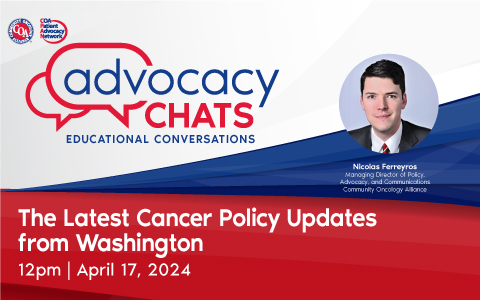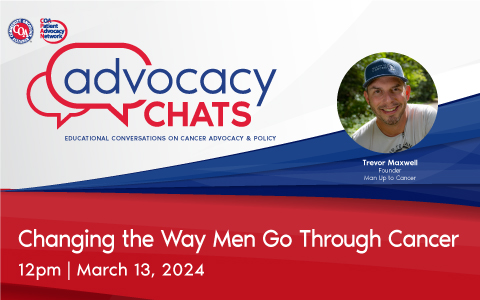What Is High Quality Cancer Care?
One of the most important aspects of cancer care is finding the best possible care to fight this deadly disease. This Advocacy Chat focused on what high-quality cancer care is, and Bo Gamble, COA’s director of quality and value, discussed the components of quality cancer care.
Rose Gerber announced that Harsha Vyas, MD, FACP, Cancer Center of Middle Georgia, will be joining Miriam Atkins, MD, FACP, Augusta Oncology, as a CPAN medical co-chair. Dr. Vyas’ practice in Dublin, Georgia, is among the most sophisticated, state-of-the-art facilities, further underscoring that quality cancer care is available in large cities and small towns across America, and free-standing, physician-owned cancer practices, both large and small, provide high-quality cancer care.
What is High-Quality Cancer Care?
Most patients ask questions about their care and wonder how they can know what quality cancer care is. Just as patients try to identify quality care, cancer care teams wonder if they are delivering high quality care, and insurance companies and employers want to know they are securing the highest quality care. Everyone wants quality care, but not everyone can always define it.
Care has to go beyond the oft heard, “I love my doctor!” Patients must know the specifics of what to expect. During the March Advocacy Chat, the care components of the Oncology Medical Home (OMH) were discussed as pieces of the complete cancer journey. To ensure that cancer care centers continue to deliver quality care, there is a patient-centered certification process to measure and validate that they deliver monitored and continuously improving care.

The Components of the Oncology Medical Home
All seven components of quality cancer care should have the patient at the center. If they do not, practices need to re-think their process to bring patients to the center.
Regardless of where patients receive their care, the seven care components should be a guide for the delivery of cancer care. Regardless of who is delivering cancer care, or where it is delivered, these criteria should guide all those who provide cancer care. Every patient who seeks care should look for these criteria as the basis on which they evaluate their own care.
Patient Engagement
The process begins with Patient Engagement. There are specific conversations that need to happen when a patient is diagnosed. As they begin their cancer journey, patients can be scared, worried, and concerned. One of the first discussions patients have is about their care plan. This will include things like:
- How care will impact the patient’s schedule
- How care might impact the patient’s family
- What tests will be performed during the course of treatment
Patients should get specific, personalized details of their care plan and what to expect. Early in the plan there should be a discussion on the cost of care, including what they can expect budget-wise. There must also be a discussion on how the team can help the patient with any budget issues, through such things as drug assistance programs or foundation money. Patients should not have to go through their cancer journey with the weight of financial toxicity.
Another part of this conversation must be what will happen when treatment is over, and the patient is cured or in remission. Patients must understand the role their cancer care team plays as a support system once they are no longer in active treatment. The team should discuss how they will remain engaged on an ongoing basis. Patient engagement is at the heart of the trust that must exist between the patient and the cancer care team. That first trusted contact may not always be the physician. Often there is a team member who is gifted with kindness and compassion and may be the first and most-valued patient contact.
Availability and Access to Care
Everyone has read about the high cost of health care as emergency room visits, medical testing, and hospitalizations mount. Availability and access to care are assurances provided to patients by the care team – they are there for support 24 hours a day, 7 days a week, 365 days a year with continual rapid access whenever the patient needs. This includes minimizing hospitalizations and emergency room visits by analyzing why patients are going to the hospital and how to intervene before that is necessary. If a patient is hospitalized, the team must be committed to contacting the patient soon thereafter so there is a smooth coordination between the hospital and the care team.
A practice in Texas discovered that the number of emergency room visits by their patients was unacceptably high. Upon examination, they discovered that patients who had problems after normal office hours called the practice and got caught up in a frustrating phone tree – press one if this or press two if that – and just hung up and went to the emergency room. When the practice discovered this issue, they changed after-hours coverage so calls were answered immediately by a human and emergency room visits plummeted. This is what is meant by availability and access.
Evidence-Based Medicine
Sometimes insurance companies are not fully aligned with the care team, what the team is trying to do for their patients and can place obstacles in the way. There is often confusion between a formulary (a preferred list of medications) and a list of evidence-based medicine.
While a specific treatment may be what the physician thinks is the preferred option, the question becomes what does the evidence say is the option most likely to be most effective? In most cases, there is evidence about what is most effective, and the process must be in place to make certain that the physician is abiding by that evidence. There may be deviations, and in that case the physician should explain why a deviation is preferable. This can be because of other conditions that must be considered when treating a specific patient. If a trend develops, it may be necessary to research additional evidence-based options.
This is an area where clinical trials can play a significant role. The standard is not that patients must be in a clinical trial, but that clinical trials must be an option offered to patients. If the care team does not have clinical trials available, they must provide easy access to someone that does. When in private practice, Bo was with a rural practice, but had a lead physician who was amongst the nation’s leading proponents of clinical trials. Working with the physician, the practice set up protocols that made it easy to offer clinical trials as a treatment option. This is a way every provider can offer state-of-the-art medicine no matter their size or location. Both Bo and Rose would argue that having seen the management and support required during a clinical trial, care is two to three times more intense – more phone calls, more checking in, more visits.
Equitable and Team-Based Care
This is a difficult and wide-ranging component. It means determining if patients are being given the everyday care they need in addition to their cancer care. As with any other group, for each team member to do their part well, there must be the administrative and organizational leader of the group. This leader must direct and coordinate the care internally and externally.
An excellent example is a clinic in New Mexico where a community oncologist observed that breast cancer screenings on area Indian reservations were needed. Because the patients did not trust area oncologists, the practice reasoned they needed to go to the patients. This sounded like a promising idea of how to provide equitable care and to diminish care disparities. The practice purchased a van, went to the reservation, and offered breast cancer screenings; however, there was little participation. Why? Because the residents believed that going into the van would give the women breast cancer. This mindset prevented access to care. There are other factors that prevent access to care as well, like transportation or cost. Whatever the factor that impacts access to care, care teams must find ways to overcome these barriers. The responsibility of the cancer care team goes far beyond the tumor.
Quality Improvement
It is not enough that the cancer care team performs all the components of the care plan well on the first day a patient is seen in the office. The team must demonstrate an ongoing compliance to the criteria and expectations, even on days when the patient is not present. In addition, the team must pursue, respond to, study, and address patient feedback. COA recommends several survey tools that can help a practice evaluate and improve performance.
Feedback must also be shared at the physician level, a process that does not always go smoothly. Often, physicians will presume that performance deficiencies refer to others and not to themselves. Existing patient surveys have been modified to include data about performance on an individual basis. The examination of this more detailed data has sparked comparisons of how specific situations are handled and how alternative techniques can be employed to generate greater patient satisfaction. The standard has been set that each team must identify, address, and show improvement on at least one quality improvement objective every six months. Care teams must pursue higher and higher quality care at every turn.
Chemotherapy Safety
As a patient with cancer begins treatment, chemotherapy safety is of the utmost importance. Chemotherapy must occur in a safe and consistent manner for the patient and the staff, with everyone following the same criteria. There are 22 standards within the Oncology Medical Home regarding chemotherapy safety. These standards control double validations, processing for different drugs, and sterile and non-sterile room protocols. Everybody must be working from the same guidelines to make certain that treatment is as safe as possible.
COA partners with the American Society of Clinical Oncology (ASCO) to establish chemotherapy safety standards, ensuring these standards are adhered to, and proving that adherence with measures. This program may be the most meaningful program in the cancer care system.

Goals of Care – Palliative and End of Life Discussions
Palliative and end of life care goals range from legal aspects like making sure the patient has completed an advance directive to a heartfelt, comprehensive, and honest discussion when all known therapies have been explored and results have not proved curative nor put the patient’s cancer in remission. From there, care teams must work with the patient to determine what they desire, the best next steps, and how the patient wishes to spend their last days with family.
It is important to have that discussion and sometimes it is best to stop treatment. It is okay for patients to say that their last wishes are to be with their family, in their home, or on their porch. The patient may ask that the cancer care team keep them comfortable and how the team will support that decision. This discussion can be extremely difficult, but it must be had.
Physicians are not always trained to think this way. They are trained to say, “hope, hope, hope.” They may suggest treatment up until a patient’s last day because that is what they were trained to do. More recently, many have come to believe there is a better way to balance that training with the patient’s wishes. In other instances, the patient and the family may not agree on what to do. The care team must facilitate an open discussion to reach a decision.
Where Are We Now?
The certification achieved by the 12 current OMH practices is not an easy process. The eight community oncology teams, two universities, and two hospitals that are certified as Oncology Medical Home worked diligently to meet the difficult standards necessary to consistently provide the quality care required. COA provided coaching and guidance to aid in the process. The participants will submit their final criteria in May 2022. After that, COA hopes to roll out this program to every cancer care provider in the country; to insurance companies as a guide about what they should be looking for when seeking cancer care providers; and to employers about what to look for when adjusting insurance benefits.
The Oncology Medial Home program is leading to many and varied improvements in the cancer care delivery system and is well received by patients, providers, employers, and payers alike.
This event will be part of our virtual CPAN Advocacy Chats series – short, monthly educational webinars on key cancer issues and the policies that impact them. Each month will feature a new topic and special guests joining us. Patients, survivors, caregivers, and other cancer care advocates are all invited to join us for these free, interactive, virtual events!
CPAN Advocacy Chats are regular virtual 30-minute educational conversations about cancer advocacy and policy with a guest speaker invited to discuss issues important to patients and advocates. Summaries of previous Advocacy Chats are available on the CPAN website.
Past Advocacy Chats





